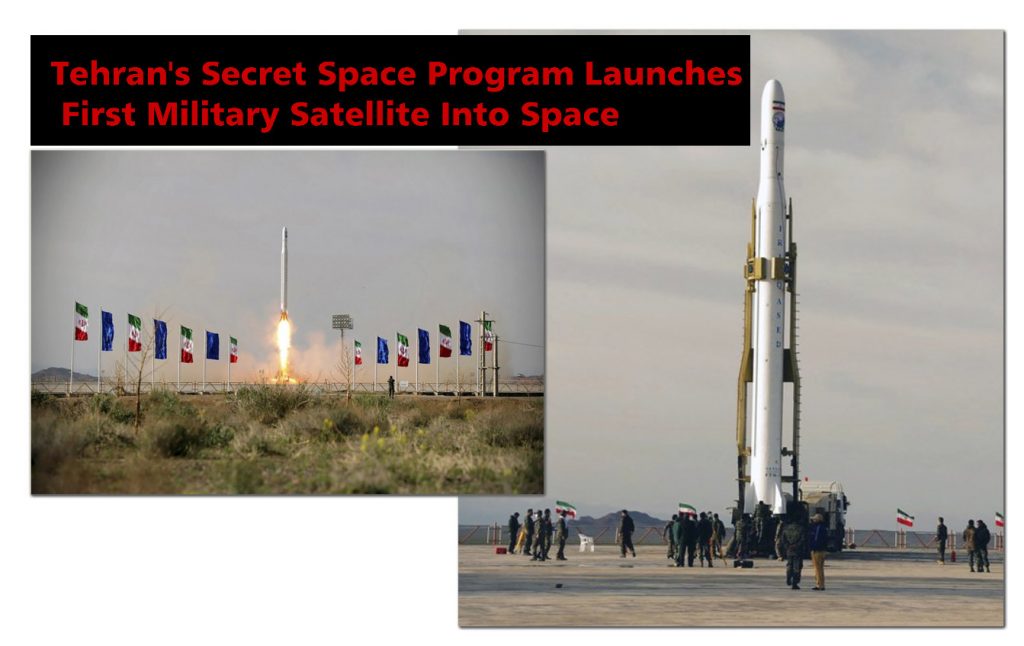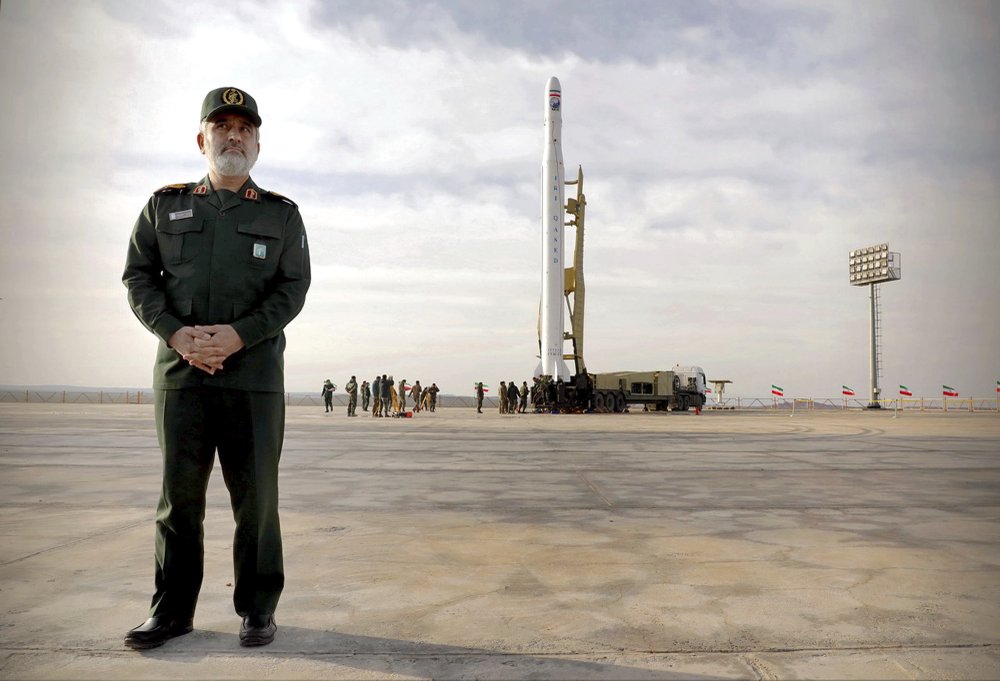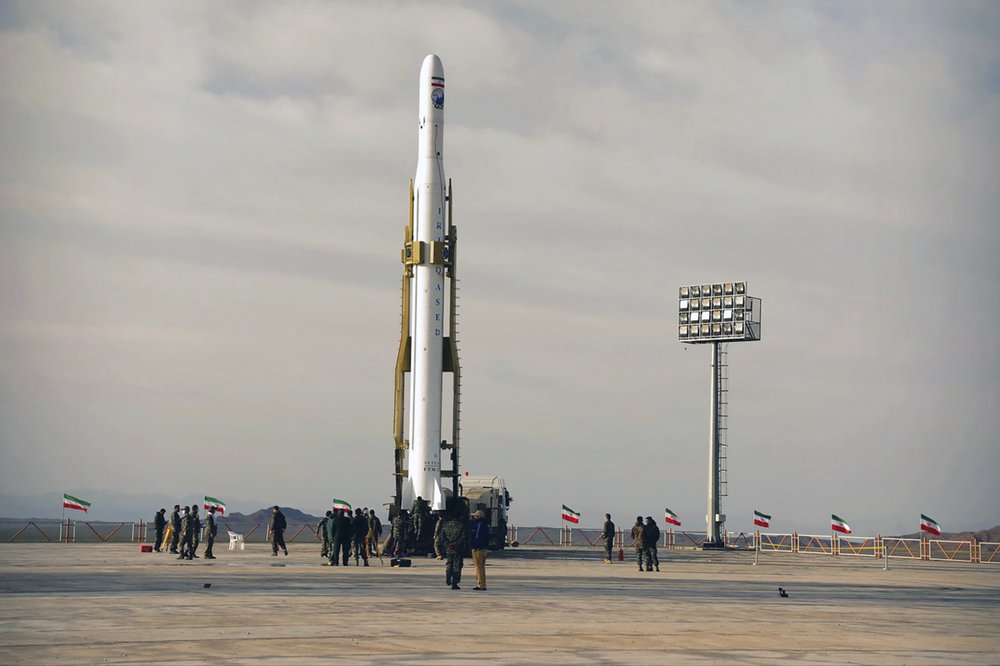
This launch proved Tehran was apparently developing a secret military space program.
The satellite launches defy a U.N. Security Council resolution calling on Iran to undertake no activity related to ballistic missiles capable of delivering nuclear weapons. American officials, as well as European nations, worry that these launches could help Iran develop intercontinental ballistic missiles capable of carrying nuclear weapons.
The IRGC successfully put Noor (light) into orbit on Wednesday morning 22 April 2020. The homegrown satellite was launched with a three-stage satellite carrier, indicating that the satellite is in orbit, distance of 425 km (264 miles) from the Earth’s surface. Dubbed Qassed (messenger), from a launch pad in Dasht-e Kavir, a large desert in central Iran. It was the first successful launch of a military satellite into space. The launch comes as Iran has abandoned all the limitations of its tattered nuclear deal.
Video Iran IRGC 1st Military Satellite, Noor-1 Satellite launched into orbit
The launch of Iran’s first military satellite has been deemed a success by U.S. Space Command. The 18th Space Control Squadron tweeted Wednesday that it tracked “2 objects from #space launch originating in Iran.” The U.S. State Department and the Pentagon both say such launches advance Iran’s ballistic missile program. On its official website, Iran’s paramilitary Revolutionary Guard said the satellite successfully reached an orbit of 264 miles above the Earth’s surface.
Video: IRGC’s satellite sends first footage from space

Major General Salami said the IRGC has made a great stride in promoting the scope of strategic intelligence capabilities. “Today, we can observe the world from the space, which means the expansion of the strategic data of the IRGC’s mighty defense power.”
In comments after the launch of Iran’s first-ever military satellite “Noor” into an earth orbit, Major General Salami said the successful launch of the multipurpose satellite would elevate the country’s defense power.
It is necessary for a powerful defense force like the IRGC to acquire space technologies, the general noted, saying strong armies in the contemporary era would lack a comprehensive defense plan without reaching the space.
“The acquisition of this raising technology that sends us to space and enhances the domain of our capabilities is a strategic achievement,” he stressed.
The commander also noted that the homegrown multipurpose satellite is generating “strategic added value” for Iran both in the information technology sphere and in information warfare.
Commander of the Islamic Revolution Guards Corps Major General Hossein Salami said that the military satellite, Nour 1 (Light 1), will further boost the IRGC defense force’s strategic power of intelligence and information.
“Today, we can see the world from space and this means expansion of the strategic intelligence and information of IRGC’s powerful defense force,” General Salami said after the IRGC launched Iran’s first military satellite into space.
He added that launching the multi-task satellite can both create strategic added value in intelligence battles and power in intelligence wars.
General Salami said that all parts of the satellite, including the carrier and satellite, have been produced by the Iranian scientists despite the US sanctions, noting that the message of this important achievement is that sanctions are not an obstacle on the way of Iran’s progress and will further motivate the country to turn into a big power in the region and even the world in the new technologies.
Using a mobile launcher at a new launch site, the Guard said it put the “Noor,” or “Light,” satellite into a low orbit circling the Earth. Iranian state TV late Wednesday showed footage of what it said was the satellite and said it had orbited the earth within 90 minutes. It said the satellite’s signals were being received.
The three-stage satellite launch took off from Iran’s Central Desert, the Guard said, without elaborating.
Based on state media images, the launch appeared to have happened at a previously unacknowledged Guard base near Shahroud, Iran, some 330 kilometers (205 miles) northeast of Tehran. The base is in Semnan province, which hosts the Imam Khomeini Spaceport from which Iran’s civilian space program operates.
The paramilitary force said it used a “Qased,” or “Messenger,” satellite carrier to put the device into space, a previously unheard-of system. It described the system as using both liquid and solid fuel. Such a system may allow Iran to more quickly fuel a rocket, something crucial in an offensive weapon system, Hinz said, while stressing more information was needed about the launch.

Commander of the Islamic Revolution Guards Corps (IRGC) Aerospace Force Brigadier General Amir Ali Hajizadeh announced Iran has joined the superpowers which are capable of using combined fuel in satellite carriers after launching its first military satellite on the back of the home-made Qassed carrier.
“The satellite carrier is different from the previous ones as its propulsion system is a combination of liquid and solid fuel. The propulsion system has the same non-metal and composite body which was unveiled a while ago,” Hajizadeh said on Wednesday.
“Naturally, only the superpowers enjoy this capability and others are only consumers of this technology,” he added.
General Hajizadeh underlined that “access to the space is not a choice but an inevitable necessity and we should find our place in the space”.
Nour 1, will further boost the IRGC defense force’s strategic power of intelligence and information.
“Today, we can see the world from space and this means expansion of the strategic intelligence and information of IRGC’s powerful defense force,” General Salami said.
He added that launching the multi-task satellite can both create strategic added value in intelligence battles and power in intelligence wars.
The Islamic Revolutionary Guards Corps Aerospace Force (former Islamic Revolutionary Guards Corps Air Force, aka. IRGC Air Force; aka Sepah Pasdaran Air Force), headquartered in Tehran, Iran, is administratively separate from the regular Air Force. The IRGC Air Force was founded in 1986 when Ayatollah Ruhollah Khomeni ordered the creation of three separate branches of the Islamic Revolutionary Guard Corp. The IRGC Air Force reportedly provides close air support and lift capabilities for the IRGC’s rapid reaction units. It also operates Iran’s inventory of short and medium range ballistic missiles.

At a Pentagon news conference Wednesday, senior officials called the satellite launch a provocation.
“We view this as further evidence of Iran’s behavior that is threatening in the region,” said David Norquist, the deputy secretary of defense.
The U.S. military Wednesday was tracking two objects in orbit associated with the Iranian launch. The publicly-available orbital tracking data appeared to confirm Iranian claims that the launch was a success.
The objects presumably the Noor satellite and the Qased rocket’s upper stage were circling Earth in near-circular orbits around 270 miles, or 430 kilometers, in altitude. The orbits were inclined 59.8 degrees to the equator.
Wednesday’s mission was the first successful satellite launch by Iran since February 2015, but it was the first by the previously-unknown Qased launch vehicle. Iran’s previous satellite launch attempts used Safir and Simorgh rockets, which the country claimed pursued peaceful purposes.
The launch Wednesday showed Iran was apparently developing a secret military space program.
U.S. Secretary of State Mike Pompeo condemned Wednesday’s launch.
“The Iranians have consistently said that these missile programs were disconnected from their military, that these were purely commercial enterprises,” Pompeo said during a press conference Wednesday. “I think today’s launch proves what we’ve been saying all along here in the United States: The IRGC, a designated terrorist organization, launched a missile today.”
Gen. John Hyten, vice chairman of the Joint Chiefs of Staff, said the launched vehicle “went a very long way.” He said it was too early to say whether it successfully placed a satellite in orbit.
Israel’s Foreign Ministry described the launch as a “façade for Iran’s continuous development of advanced missile technology.” German Foreign Ministry spokesman Christofer Burger warned that “the Iranian rocket program has a destabilizing effect on the region and is also unacceptable in view of our European security interests.”
U.S. Army Maj. Rob Lodewick, a Pentagon spokesman, told The Associated Press that American officials continue to monitor Iran’s program.
“While Tehran does not currently have intercontinental ballistic missiles (ICBMs), its desire to have a strategic counter to the United States could drive it to develop an ICBM,” Lodewick said.
The U.S. alleges such satellite launches defy a U.N. Security Council resolution calling on Iran to undertake no activity related to ballistic missiles capable of delivering nuclear weapons.
Iran, which long has said it does not seek nuclear weapons, previously maintained its satellite launches and rocket tests do not have a military component. The secret space program and the IRGC launching its own satellite now calls that into question.






